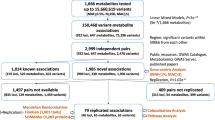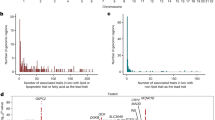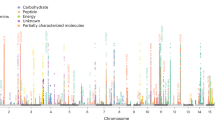Abstract
Serum metabolite concentrations provide a direct readout of biological processes in the human body, and they are associated with disorders such as cardiovascular and metabolic diseases. We present a genome-wide association study (GWAS) of 163 metabolic traits measured in human blood from 1,809 participants from the KORA population, with replication in 422 participants of the TwinsUK cohort. For eight out of nine replicated loci (FADS1, ELOVL2, ACADS, ACADM, ACADL, SPTLC3, ETFDH and SLC16A9), the genetic variant is located in or near genes encoding enzymes or solute carriers whose functions match the associating metabolic traits. In our study, the use of metabolite concentration ratios as proxies for enzymatic reaction rates reduced the variance and yielded robust statistical associations with P values ranging from 3 × 10−24 to 6.5 × 10−179. These loci explained 5.6%–36.3% of the observed variance in metabolite concentrations. For several loci, associations with clinically relevant parameters have been reported previously.
This is a preview of subscription content, access via your institution
Access options
Subscribe to this journal
Receive 12 print issues and online access
$209.00 per year
only $17.42 per issue
Buy this article
- Purchase on SpringerLink
- Instant access to full article PDF
Prices may be subject to local taxes which are calculated during checkout


Similar content being viewed by others
References
Gieger, C. et al. Genetics meets metabolomics: a genome-wide association study of metabolite profiles in human serum. PLoS Genet. 4, e1000282 (2008).
Altmaier, E. et al. Bioinformatics analysis of targeted metabolomics—uncovering old and new tales of diabetic mice under medication. Endocrinology 149, 3478–3489 (2008).
Köttgen, A. et al. Multiple loci associated with indices of renal function and chronic kidney disease. Nat. Genet. 41, 712–717 (2009).
Kathiresan, S. et al. Six new loci associated with blood low-density lipoprotein cholesterol, high-density lipoprotein cholesterol or triglycerides in humans. Nat. Genet. 40, 189–197 (2008).
Willer, C.J. et al. Newly identified loci that influence lipid concentrations and risk of coronary artery disease. Nat. Genet. 40, 161–169 (2008).
Aulchenko, Y.S. et al. Loci influencing lipid levels and coronary heart disease risk in 16 European population cohorts. Nat. Genet. 41, 47–55 (2009).
Kathiresan, S. et al. Common variants at 30 loci contribute to polygenic dyslipidemia. Nat. Genet. 41, 56–65 (2009).
Sabatti, C. et al. Genome-wide association analysis of metabolic traits in a birth cohort from a founder population. Nat. Genet. 41, 35–46 (2009).
Hindorff, L.A., Junkins, H.A., Mehta, J.P. & Manolio, T.A. A Catalog of Published Genome-Wide Association Studies (Office of Population Genomics, National Human Genome Research Institute, National Institutes of Health, Bethesda, Maryland, USA, accessed 14 April 2009). <http://www.genome.gov/26525384>.
Vaxillaire, M. et al. The common P446L polymorphism in GCKR inversely modulates fasting glucose and triglyceride levels and reduces type 2 diabetes risk in the DESIR prospective general French population. Diabetes 57, 2253–2257 (2008).
Prokopenko, I. et al. Variants in MTNR1B influence fasting glucose levels. Nat. Genet. 41, 77–81 (2009).
Gross, E. et al. Strong association of a common dihydropyrimidine dehydrogenase gene polymorphism with fluoropyrimidine-related toxicity in cancer patients. PLoS One 3, e4003 (2008).
Chen, Y. et al. Thermolabile phenotype of carnitine palmitoyltransferase II variations as a predisposing factor for influenza-associated encephalopathy. FEBS Lett. 579, 2040–2044 (2005).
Kido, H., Kinoshita, M., Mizuguchi, H. & Takahashi, N. Method of diagnosing the risk of thermolabile phenotype diseases by using gene. Japanese patent PCT/JP2005/021294 (2007).
Wichmann, H.E., Gieger, C. & Illig, T. KORA-gen–resource for population genetics, controls and a broad spectrum of disease phenotypes. Gesundheitswesen 67 (Suppl. 1), S26–S30 (2005).
Marchini, J., Howie, B., Myers, S., McVean, G. & Donnelly, P. A new multipoint method for genome-wide association studies by imputation of genotypes. Nat. Genet. 39, 906–913 (2007).
Ramsay, S.L., Stoeggl, W.M., Weinberger, K.M., Graber, A. & Guggenbichler, W. Apparatus and method for analyzing a metabolite profile. US Patent 2007/0004044 (2007).
Weinberger, K.M. Metabolomics in diagnosing metabolic diseases. Ther. Umsch. 65, 487–491 (2008).
Weinberger, K.M. & Graber, A. Using comprehensive metabolomics to identify novel biomarkers. Screening Trends in Drug Discovery 6, 42–45 (2005).
Wenk, M.R. The emerging field of lipidomics. Nat. Rev. Drug Discov. 4, 594–610 (2005).
Wang-Sattler, R. et al. Metabolic profiling reveals distinct variations linked to nicotine consumption in humans—first results from the KORA study. PLoS One 3, e3863 (2008).
Andrew, T. et al. Are twins and singletons comparable? A study of disease-related and lifestyle characteristics in adult women. Twin Res. 4, 464–477 (2001).
Brookes, K.J., Chen, W., Xu, X., Taylor, E. & Asherson, P. Association of fatty acid desaturase genes with attention-deficit/hyperactivity disorder. Biol. Psychiatry 60, 1053–1061 (2006).
Caspi, A. et al. Moderation of breastfeeding effects on the IQ by genetic variation in fatty acid metabolism. Proc. Natl. Acad. Sci. USA 104, 18860–18865 (2007).
Tanaka, T. et al. Genome-wide association study of plasma polyunsaturated fatty acids in the InCHIANTI Study. PLoS Genet. 5, e1000338 (2009).
Gregersen, N. et al. Identification of four new mutations in the short-chain acyl-CoA dehydrogenase (SCAD) gene in two patients: one of the variant alleles, 511C→T, is present at an unexpectedly high frequency in the general population, as was the case for 625G→A, together conferring susceptibility to ethylmalonic aciduria. Hum. Mol. Genet. 7, 619–627 (1998).
Nagan, N. et al. The frequency of short-chain acyl-CoA dehydrogenase gene variants in the US population and correlation with the C4-acylcarnitine concentration in newborn blood spots. Mol. Genet. Metab. 78, 239–246 (2003).
Acknowledgements
The KORA (Kooperative Gesundheitsforschung in der Region Augsburg) research platform and the MONICA (Monitoring trends and determinants on cardiovascular diseases) Augsburg studies were initiated and financed by the Helmholtz Zentrum München−National Research Center for Environmental Health, which is funded by the German Federal Ministry of Education, Science, Research and Technology and by the State of Bavaria. Part of this work was financed by the German National Genome Research Network (NGFNPlus: 01GS0823) and by grants from the 'Genomics of Lipid-associated Disorders–GOLD' of the 'Austrian Genome Research Programme GEN-AU'. Computing resources have been made available by the Leibniz Supercomputing Centre of the Bavarian Academy of Sciences and Humanities (HLRB project h1231) and the DEISA Extreme Computing Initiative (project PHAGEDA). Part of this research was supported within the Munich Center of Health Sciences (MC Health) as part of LMUinnovativ. The TwinsUK study was funded by the Wellcome Trust, European Community's Seventh Framework Programme (FP7/2007-2013)/grant agreement HEALTH-F2-2008-201865-GEFOS and (FP7/2007-2013), ENGAGE project grant agreement HEALTH-F4-2007-201413 and the FP-5 GenomEUtwin Project (QLG2-CT-2002-01254). The study also received support from the Department of Health via the UK National Institute for Health Research (NIHR) comprehensive Biomedical Research Centre award to Guy's & St. Thomas' NHS Foundation Trust in partnership with King's College London (T.D.S.). The project also received support from a UK Biotechnology and Biological Sciences Research Council (BBSRC) project grant (G20234). We acknowledge the funding and support of the US National Eye Institute (NEI) via a US National Institutes of Health (NIH) and Center for Inherited Disease Research (CIDR) genotyping project (principal investigator T. Young). We acknowledge the contributions of P. Lichtner, G. Eckstein, G. Fischer, T. Strom and all other members of the Helmholtz Zentrum München genotyping staff in generating the SNP data set, T. Halex and A. Sabunchi to the metabolomics measurements, and of all members of the field staffs who were involved in the planning and conduct of the MONICA and KORA Augsburg studies. The KORA group consists of H.-E.W. (speaker), A. Peters, C. Meisinger, T.I., R. Holle, J. John and their co-workers who are responsible for the design and conduct of the KORA studies. For the TwinsUK study, we thank the staff from the Genotyping Facilities at the Wellcome Trust Sanger Institute for sample preparation, quality control and genotyping led by L. Peltonen and P. Deloukas, Le Centre National de Génotypage (France), led by M. Lathrop, for genotyping, Duke University, North Carolina, USA, led by D. Goldstein, for genotyping and the Finnish Institute of Molecular Medicine, Finnish Genome Center, University of Helsinki, led by A. Palotie. Genotyping was also performed by the CIDR as part of an NEI and NIH project grant. Finally, we thank all participants of the KORA and the TwinsUK studies.
Author information
Authors and Affiliations
Contributions
T.I., T.D.S., J.A. and K.S. designed the experiment; T.I., C.G., T.M. and H.-E.W. contributed genetics data and analysis from the KORA study; G.Z., B.S.K., N.S. and T.D.S. contributed genetics data and analysis from the TwinsUK study; W.R.-M., R.W.-S., C.P., G.K., H.-W.M., M.H.d.A., T.D.S., J.A. and K.S. contributed to the metabolomics experiments; C.G., G.Z., E.A. and K.S. analyzed the data; C.G., F.K., N.S. and K.S. wrote the manuscript; all authors contributed their critical reviews of the manuscript during its preparation.
Corresponding author
Supplementary information
Supplementary Text and Figures
Supplementary Tables 3–4, Supplementary Figures 1–3 and Supplementary Note (PDF 1128 kb)
Supplementary Table 1
Association data for all SNPs associated with metabolite traits (XLS 2377 kb)
Supplementary Table 2
Association data for 50 strongest associations with metabolite traits (XLS 327 kb)
Rights and permissions
About this article
Cite this article
Illig, T., Gieger, C., Zhai, G. et al. A genome-wide perspective of genetic variation in human metabolism. Nat Genet 42, 137–141 (2010). https://doi.org/10.1038/ng.507
Received:
Accepted:
Published:
Issue Date:
DOI: https://doi.org/10.1038/ng.507



